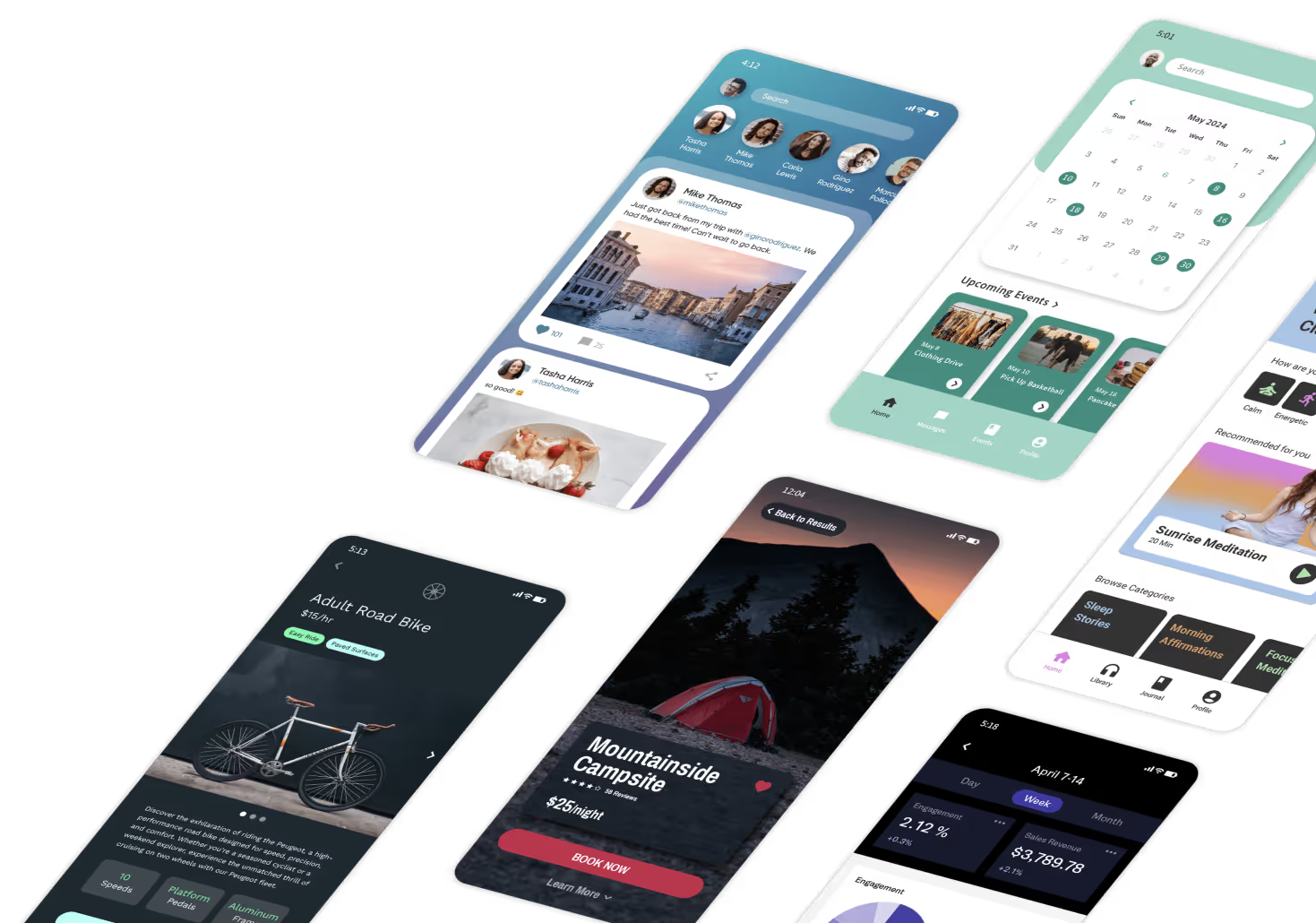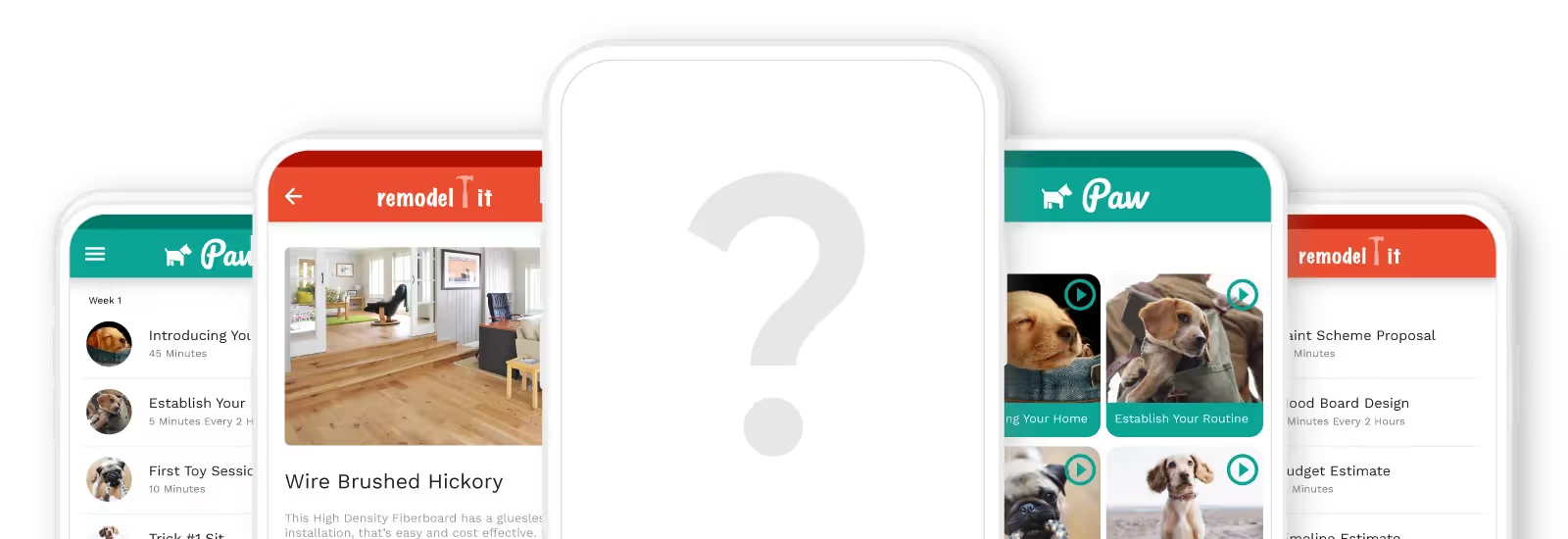
Did you know that with no-code platforms like Adalo, you can easily customize pre-built apps and then sell them? This can be a splendid side hustle, hobby, or career.
This article will walk you through the following:
- Overview of white label apps
- How to build white label apps using Adalo
- Tips for selling white label apps
- Tips for launching a no-code white label app business
- FAQs and why you should build your app with Adalo
Let’s now look at what white label apps are and who they’re best for.
What Is a White Label Mobile App?

White label apps are blank, pre-made mobile apps that can be customized, edited, and tweaked for a particular service or brand. They can be developed by one company but custom-crafted, rebranded, and sold by another company as their own, matching its brand image and logo.
You can use a no-code app builder like Adalo to develop a white label app. Adalo’s an ideal choice because you don’t need any coding skills or technical knowledge to use it — choose a premade template and customize your app using Adalo’s simple drag-and-drop interface.
Just what kind of white label app can you build? The possibilities are endless, but an app for booking restaurant tables is a standard white label solution. You can build a nice, user-friendly layout, including scheduling and booking features, payment integration, and more.
Then, the app can be marketed to restaurants and customized to fit the colors and logo that the restaurant owners prefer.
Knowing more about mobile app development is essential if you’re going to be building white label apps. Read the ultimate guide next to continue your education.
Who Are White Label Mobile Apps Best for?
Often, white label apps are developed by agencies, franchises, and freelancers and sold to businesses needing quick cost-effective software solutions.
However, larger companies and organizations with complex and ever-evolving software needs can also develop these apps in-house, as they’re helpful in meeting the needs of different internal departments.
Benefits of Building White Label Mobile Apps

Creating white label apps comes with quite a few positives, including the following:
- It saves time: One of the most significant advantages of a white label app is that it saves product development time. A small team doesn’t have to build from scratch and reinvent the wheel. They can launch faster and get their app to the public without as much project management, planning, or procedure.
- It’s cost-effective: With a white label mobile app, small businesses don’t need to spend resources to develop an app or hire a developer. White label app development companies sell their apps for many enterprises, so they don’t charge you for the entire development cost.
In most cases, buying a ready-made app that you can customize will cost much less than building a custom app.
- Opportunities to scale and bring home the bread: Creating white label apps allows you to scale your business, reach new customers, and tap into a new market. If you develop a simple and effective white label app that many players in an expansive industry want, profits could be lucrative.
For instance, creating a solid white label app for restaurants appeals to an expansive market, and if many players want your app, they might reward you handsomely.
- Lower maintenance effort and costs: Many app-building platforms, like Adalo, Glide, and Draftbit, offer maintenance and ongoing bug fixes to help keep your app running smoothly. This means you won’t have to worry so much about the technical aspect of app development, freeing up more time for you to create more white label apps!
- Easy branding: White label apps offer easy branding opportunities because they usually come without any kind of customization. Simply add your brand identity, logos, and colors, and you’re good to go!
Drawbacks of Using White Label Apps
Unfortunately, white label apps aren’t all peaches and cream — here are a few cons that come with building a white label app:
- Limited customization: While essential elements like logos, colors, and copy can usually be adjusted, deeper customizations, like modifying core features and workflows or integrating niche functionalities, are often restricted. For instance, if you need advanced functionality, like transferring data from a few different APIs to your app, a white label app might not be able to serve you.
- Platform dependency: If you develop a white label app on a no-code or low-code platform, you’ll have to rely entirely on it for updates, maintenance, and technical support. This means you’ll need to continually keep up with platform updates, technology implementations, and more. Additionally, if the platform’s technical team suddenly stops smashing bugs or updating the software, your app’s performance will suffer.
- Competition: While competition is inevitable and sometimes can be a good thing, it’s a significant barrier to entry if you’re considering launching a white label app development company or starting a freelancing gig. The industry is quite saturated, so creating a unique, almost unicorn-like value proposition is critical if you want to see any growth. Achieving this in a crowded space will most likely be a difficult task.
While building white label apps has a set of challenges, it can also be rewarding and helpful.
How To Build a White Label Mobile App with Adalo

As we mentioned earlier, Adalo is a great app builder for crafting white label apps: It’s easy enough to learn right off the bat and provides the flexibility to create nearly any kind of app you can imagine.
Here’s a step-by-step crash course for creating a white label app using Adalo:
Step 1: Choose Your Niche and Plan
First, identify a specific market or business type that needs white label apps. These could be fitness businesses, restaurants and cafes, salons, and others. Then, grab a piece of paper and a pen, and jot down the following:
- Issues and problems your app will solve
- Features and functionalities you wish to add, like a scheduling tool, in-app messaging function, and more
- Simple blueprint of the screens, structure, and layout of your app
These plans will help guide you through the app-building process, providing you with direction so you’re not shooting from the hips. With proper plans, you also ensure you don’t forget to add anything major either.
Step 2: Get Adalo’s Free Version
Once you’ve developed your plans, it’s time to put in some elbow grease and get the app-creation process rolling. Luckily, you can build a simple app for free with Adalo.
Adalo features one of the most generous free versions when compared to other no-code app builders, which you can use to make an MVP for approaching clients. You’ll be able to publish your app to the web, so users can access it with their phone or desktop browsers. The platform also provides access to power-boosting integrations, like Stripe, for accepting payments.
After navigating to Adalo’s signup page and entering your personal information, you’ll be ushered to Adalo’s app-building interface. Adalo offers great free templates — just select one and you’re off to the races.
Step 3: Build Your App
Many no-code app builders have a complex and difficult-to-learn app-building interface. This isn’t the case with Adalo, as it’s one of the most intuitive and user-friendly app builders. It’s so simple that you can start building your app without watching tutorials or reading about the building interface.
Adalo’s building interface is made up of the following 3 components:
- Horizontal Ribbon: Expanding horizontally across the top of your screen, this is where you can access your Adalo account settings and preview your app.
- Building Canvas: Located in the middle of your screen, this is your app’s “live blueprint.” You can see all the new changes you make to your app right on your building canvas.
- Editing Dashboard: This is found on the far left-hand side of your screen. It drops down vertically and has all the functions you need to craft your app. You can change the colors, and drag over pre-built tasks like forms, elements, buttons, and more to your Building Canvas.
Adalo also boasts a database and backend builder, so you won’t need to find, learn, or pay for a third-party builder. Because it’s a one-stop shop, you can develop your white label app quickly and easily using Adalo.
Step 4: Test and Deploy Your App
Once you’ve cobbled your app together, it’s time for some testing. Doing this ensures that you don’t release an app that’s prone to crashing or riddled with other errors. Share your app with a select group of testers to gather feedback on functionality, design, and performance.
Adalo makes doing this a breeze, as you’ll be able to send a link or QR code to your app’s website on the Horizontal Ribbon. Send your app out to a few testers, and implement the feedback they offer into your app.
When you build with Adalo, you can also publish your app to the Apple App Store and Google Play Store. Before doing so, you’ll need to create developer accounts with Android for the Google Play Store and iOS for the Apple App Store.
Both iOS and Android provide testing platforms that let testers download the app's mobile version, try it out, and give you feedback about its performance. Taking advantage of these testing features will help ensure that your app passes app-store publishing standards, so you can release a flawless and read-to-sell white label app.
Tips for Selling White Label Mobile Apps
Once you’ve created your white label app, it’s time to remove your app-developer hat and put on your sales rep hat.
Here are a few tips to up your white label app sales game:
Research Potential Clients
Since you already know your clients' industry and niches, it’s time to start prospecting. Identify potential customers who would benefit from your white label app and start building a list.
Then, research their businesses and understand their specific challenges and needs. Aim to express how your white label app can bolster their operations. For example, if you’re targeting restaurants, highlight features like online ordering, reservation management, or push notifications for promotions.
It’s also a good idea to determine if the client already uses an app for their operations. Do this by searching for clients on the Apple App Store and Google Play Store, or seeing if their website has app functionalities (like ordering food, booking appointments, and more).
Businesses without apps are prime potential clients. And don’t despair if your target businesses already use an app — you can try and position yours as a powerful alternative.
We recommend you create a list of at least 100 potential clients that you’ll pitch. Not every potential client will want to purchase your white label app, so it’s good to have a long list of potential targets.
Pitch
After you’ve finished your client research, it’s time to start approaching them. You can find client contact information via their websites or on LinkedIn. Additionally, you can send your clients direct messages through social media platforms like Instagram, Facebook, and X.
You’ll need to design a pitch that emphasizes your app’s selling points. Take your time when doing this, and experiment with friends and colleagues, asking for their feedback. Once you’ve perfected your pitch, start reaching out to those potential clients on your list.
The main goal of your pitch is to book a meeting with potential clients, during which you will demonstrate your app.
For more about pitching, we wrote up how to pitch investors on your app idea which can help you take your business to new heights.
Demonstrating Your App
A compelling demonstration is a powerful way to showcase your app’s value. First, prepare a live demo app customized and branded app that resonates with your target market. Doing this will show potential clients how your white label app can be transformed into one with custom branding.
Focus on user experience (UX) when demonstrating your app. Your potential clients or their customers will be the ones using your app, and if it’s clunky and slow, your potential clients’ operations and business will suffer.
Illustrate how your app swiftly navigates from screen to screen. Emphasize simplicity by showing that customers can book tables with just a couple of screen taps or receive KPI data with a button. If your app adds value by saving time, more clients will likely purchase your white label app.
Offer Customization Packages
It goes without saying, but each client will have different customization needs — each client’s branding, colors, and preferred layout will differ. Luckily, one of the key selling points of white label mobile apps is the ability to tailor them to meet the unique needs of different businesses.
Give your potential clients tiered customization packages, allowing them to choose a level of customization that suits their budget and requirements. For example, your basic package could include branding elements such as incorporating the client’s logo, color scheme, and fonts.
Mid-tiers can offer custom features like integrations with specific third-party tools like CRMs or payment gateways. Premium customization tiers could provide an in-depth user interface redesign, an analytics dashboard, and more features like push notifications.
Ultimately, being presented with more than one option will help you immensely. Businesses have different needs, and being able to cover those needs with other types of white label apps increases your chances of closing a client.
How to Price White Label Mobile Apps
Now, it’s time to put that sales rep hat back on the rack and put on your financial manager hat.
Here are some ways to price your white label mobile app:
- Upfront Fees: These are an essential component of pricing white label mobile apps. They serve as a one-time payment made by the client to initiate the building. To determine a fair upfront fee, consider the scope of work involved. It goes without saying, but each of your pricing tiers should have different upfront fees, mainly to reflect the inordinate amount of work that goes into each app type.
- Recurring Fees: Recurring fees are typically charged monthly or annually and are tied to services such as app hosting, updates, maintenance, or premium features like analytics and push notifications. These fees help cover ongoing costs and provide a steady income stream, making your business more sustainable over time.
- One-Time Customization Fees: These enable you to offer tailored solutions while maintaining profitability. They apply when a client requests specific modifications to the standard white label app, such as branding, unique features, or enhanced functionality.
Customization can include integrating the client’s logo, color schemes, and custom layouts, or incorporating specific business-oriented tools like appointment scheduling, e-commerce platforms, or loyalty programs.
Sample Pricing Models
To give you an idea of how to offer your pricing, we designed 3 separate tiers below:
- Basic Plan ($500 setup fee + $50/month): This plan caters to small businesses or startups that are looking for an affordable solution. It will include features like a fully branded app with your logo, custom color themes, and a simple user interface tailored for easy navigation.
- Advanced Plan ($1,000 setup fee + $100/month): In addition to all the features of the Basic Plan, this tier includes features like push notifications, analytics dashboards, in-app messaging, and others. It’s designed for businesses that have more complex operations, and therefore need a more involved set of functionalities.
- Custom Plan ($2,000 setup fee + $200/month): Crafted for businesses that demand top-tier performance, extensive features, and ongoing support, the Custom Plan has all the features of the Advanced Plan, along with premium benefits such as unlimited user accounts, real-time data syncing, advanced analytics with AI-powered insights, and access to exclusive integrations. It’s more geared towards larger businesses that have a complex set of software needs.
These plans can cover a wide range of industries and app-building needs, which can make your white label app competitive and flexible, offering you loads of opportunities to boost your income.
3 Tips for Launching a No-Code White Label App Business
Now that you’re equipped with some essential knowledge about creating a white label app with an app builder like Adalo, how to find potential clients and pitch your app, and how to determine pricing tiers, you’re nearly set.
Here are a few more pointers:
Pick a Profitable Niche
Focus on industries or sectors that benefit most from mobile apps and consistently demand such solutions. These include gyms, restaurants, real estate businesses, healthcare providers, and e-commerce businesses.
Additionally, a well-defined niche allows you to tailor your offerings, messaging, and marketing efforts to meet the specific needs of your target audience, making it easier to stand out in the market.
Want help generating app ideas? Check out our ultimate guide with 50 options.
Start Small, Scale Fast
It’s tempting to target a broad audience immediately. However, doing so can spread you too thin, making it difficult to pitch your app properly. Starting small lets you focus on a specific niche, refine your processes, and build a solid foundation. Begin by targeting a single industry where white label apps are in demand.
This focused approach helps you understand the unique needs of your initial audience and tailor your offerings accordingly.
Once you’ve gained traction, scale fast by replicating your proven processes for other niches or markets, using your past success as examples when pitching new clients. Doing this can help you gain invaluable experience and position your business for sustainable growth in the competitive no-code app market.
Offer Excellent Support
Exceptional support is a cornerstone of success when running a no-code white label app business. For many clients, using no-code tools or managing a mobile app is uncharted territory, so you’ll need to provide guidance to ensure their app performs as expected.
Offer varying levels of support for each pricing tier. For instance, your Basic Tier could include email or text support, while higher-priced tiers could include 1-on-1 phone support where you log into the app and troubleshoot issues with your clients.
Ultimately, providing support will show your clients that you care, which could result in them sticking with you and even referring their colleagues to you. If you build with Adalo, they have a full Academy that you can share with your clients so they can answer their questions (before disturbing you!).
White Label Mobile App vs Custom Development: Which Is Best for You?
Unlike native custom apps, which are developed from scratch for a specific purpose or client, white label apps save time and development costs by providing a ready-made solution. However, custom development might win out in some situations over white label development.
Let’s look at a few different aspects of app building and see how white label app creation differs from custom-app development:
TL;DR
- White Label Apps: These are pre-built, cost-effective, and quick to deploy, but they are less scalable and limited in customization. They are ideal for businesses needing a ready-made solution, not a complex app with a long development timeline.
- Custom Development: Built from scratch using coding or an upper-tier no-code or low-code app builder. They’re highly scalable and fully customizable. Best suited for businesses requiring unique functionality and long-term adaptability. Now let’s dive into more details on these aspects.
Cost
- White Label: White label apps are significantly more cost-effective because they are pre-built and require minimal customization. Businesses only pay for branding, adjustments, and deployment, making them ideal for those on a budget or businesses with rapid deployment needs.
- Custom Development: Because they’re built from scratch, custom-made apps are more expensive. They require extensive development time, skilled teams, and resources. Several factors go into their cost including several consultations, design and editing, testing, and ongoing maintenance. This option is better suited for businesses with specific, complex needs and a larger budget.
Time to Market
- White Label: Because they’re pre-built, white labels have a significantly shorter time to market. Depending on the extent of customization required, they can be rebranded and launched within days.
- Custom Development: Custom-developed apps require a much longer development cycle, often several months or more. The process includes planning, design, building, testing, and revisions, which makes them better suited for businesses with unique needs and no immediate time constraints.
Flexibility
- White Label: Because they follow a pre-existing “one-size-fits-most” approach, white label apps offer limited flexibility. They only allow for basic changes like logos, colors, and minor features and aren’t designed to support significant structural or functional customizations.
- Custom Development: Custom apps provide maximum flexibility, allowing businesses to design and build features, workflows, and integrations tailored to their exact needs. Developers can create bespoke solutions to address unique challenges, ensuring the app aligns perfectly with the business’s goals and user expectations.
Scalability
- White Label: White label apps are typically less scalable, especially if made on an app-building platform that limits usage and bandwidth. Advanced capabilities like patching in your own JavaScript commands could be beyond the platform's capabilities, and performance can be constrained if the app's usage exceeds what the platform was designed to handle.
- Custom Development: While it’s dependent on the type of no-code or low-code platform on which they’re developed, custom apps tend to offer high scalability. This is because they are built from scratch or on a highly-flexible platform with tailored architecture to accommodate future growth. Developers can optimize performance, add new features, and adapt to increasing user demand without being restricted by third-party platform constraints.
Frequently Asked Questions
Do I Need Coding Skills to Build White Label Mobile Apps?
No, coding skills are not required to build white label mobile apps. Platforms like Adalo offer intuitive no-code tools with drag-and-drop interfaces, pre-built templates, and customization options. These tools simplify app creation, as they’re very similar to PowerPoint. Anyone who can create an email account can use Adalo.
What Industries Benefit Most From White Label Mobile Apps?
Many industries can benefit from a ready-made, easy-to-deploy white label app. For instance, restaurants, cafes, and hotels can use apps for online ordering, reservations, and customer engagement. Those in the fitness and wellness industry, such as gyms, yoga studios, and personal trainers, can leverage apps for scheduling, memberships, and progress tracking.
Can I Customize a White Label Mobile App to Match My Brand?
White label mobile apps are designed to be customizable, allowing you to match them to your brand. To reflect your branding, you can switch up key elements such as logos, color schemes, fonts, and app icons. Many platforms also let you adjust layouts and features to align with your business needs better.
Adalo: The Perfect Platform for White Label Mobile Apps
Looking for a platform to build your white label app? Look no further than Adalo.
Adalo is an incredibly easy-to-use, no-code app-building platform. It’s intuitive enough to start using right after you create an account but powerful enough to spark life into almost any white label app idea. You’ll have nearly pixel-perfect design freedom, ensuring your app looks exactly how you intend.
You can publish your white label app to the Apple App Store and Google Play Store, so your clients’ app users can download it directly to their phones, making it easy to access. Try Adalo’s free version today.














